Marc Smith visits the knockout stage of the OCBL July Cup
After four days of competition, the quarter-final stage of the Online Contract Bridge League’s July Cup are upon us. These were the line-ups (with the carryforward advantage shown in parenthesis):
| BLACK (8.1 IMPs) vs | PIGOT |
| DONNER (+6.1) vs | SCHWARTZ |
| BRAIN GLUCOSE (+3.1) vs | HUNGARY |
| ECF HOLDING (+1.1) vs | GILLIS |
There is plenty to look forward to, with an Anglo-Irish battle at Table 1 and an inter-Norwegian match-up at Table 4. Two of the three teams flying the Stars and Stripes of the USA meet head-on at Table 2, whilst two teams who have shown well over the first four days meet at Table 3.
As usual, we begin with some problems, and we shall discover later how your choices would have worked. First, a combination problem: with both sides vulnerable, you are West with:
What, if anything, do you bid?
Suppose you raise defensively to 3♥. North doubles and RHO bids 3NT. What do you lead?
Next, with just your side vulnerable, you hold as West:
What action, if any, do you take?
While you mull those over, we start our coverage of the quarter-finals. In a dull first set, ECF HOLDINGS won 19-11 to lead by 9.1 IMPs (including their carryforward advantage) and BRAIN GLUCOSE outscored the Hungarians 35-9 to lead by 29.1. There were to be no comebacks from the trailing teams in either of those matches. In the other ties, BLACK outscored the Irish 11-8 to lead by 11.1 and DONNER won the first half 11-2 to lead by 15.1, but neither of those matches were close to finished.
Most West players faced the first of this week’s problem hands. The bidding was the first point of divergence in the key match between DONNER and SCHWARTZ.

American John Kranyak, a three-time World junior champion between 2001 and 2006, stepped up to the plate and gave the ball quite a ride with a full-blooded raise to game. Neither Swede could find a double, and Marion Michelsen’s ♠J lead allowed declarer to dispose of one of his diamond losers. The defence still managed to find four winners, though: N/S +100.
At the other table, Gary Donner settled for the normal-looking defensive raise to 3♥. North came in with a takeout double, Jenny Wolpert bid a fairly obvious 3NT, and now Donner had to find an opening lead. A low spade was not the winning option: declarer won, picked up the diamonds, and ended up with an overtrick when West had to surrender a second spade trick to dummy at the end. N/S +630 and 11 IMPs to SCHWARTZ.
SCHWARTZ outscored their opponents 29-1 over the second 8-board set, overturning their 15-IMP deficit to claim their place in the semi-finals.
Curiously, at the five tables where N/S played in 3NT on this deal, three declarers received a low spade lead from West, whilst the two who played the hand from the North seat were handed the contract by East’s lead of the ♣K. Not one defender thought to lead the suit their side had bid and raised, but the play on a heart lead is seriously challenging. The winning line is not so easy to spot. Even looking at all four hands, do you see how declarer can come to nine tricks?
Let’s suppose South is declarer. The first crucial step is to win the opening lead in hand with the ♥A. You then need to play a diamond to the jack, which allows you to overcome the blockage and thus enable you can cash five rounds of the suit, discarding a spade from dummy. West can afford to pitch three spades, but East is in some difficulty. He has to keep three clubs, or declarer just plays ace and another club whilst he still has a heart stop, so East has to discard one club, one heart and his spade. Declarer has taken the first six tricks and these cards remain:
If declarer plays a spade now, West wins and East can afford to throw a club. West then plays a heart. If declarer plays another spade, East ditches a second club and the defenders cash three hearts to go with their two spades. Declarer can make no more than the eight tricks with which he started.
The winning line in the diagrammed position is for declarer to play a heart to the king at trick seven. He then leads a low club from dummy. East wins, but what can he do? If he cashes his three heart winners, he is then endplayed to lead away from his remaining club honour at trick 12. If he instead plays a low heart so that West wins with the ♥10, West cannot then avoid giving declarer a spade trick to go with the ♣A. Again, declarer makes nine tricks.
A neat ending, for sure. Do you think any declarer would have found the way home on a heart lead? I suspect that if they did, they would have been serious contenders for the IBPA ‘Best Played Hand Award’ at the end of the year.
PIGOT also gained a game swing on this deal, wiping out BLACK’s halftime advantage. For the Irish, Ciaran Coyne also raised to 3♥ on the West cards and North doubled, but Simon Hult’s decision to make a ‘pick a minor’ jump to 4NT was not a success. Gunnar Hallberg managed to escape for just one down in 5♦, but that was small compensation: N/S -100.
At the other table, Tom Paske also raised the 2♥ opening to game, but Peter Pigot found a double on the North cards. Although Donal MacAoughusa led the ♠J, allowing declarer to discard a diamond, the defenders still managed to find five tricks. North won the first round of trumps, cashed the ♣A and the ♦K, then played a third round of spades for his partner to ruff with the ♥A: N/S +500 and 12 IMPs to PIGOT.
BLACK regained the advantage as the set wore on, and led 33.1-25 when the last board was placed on the table.
The Irish E/W pair bought the hand in 3♠. Gunnar Hallberg might have led his partner’s suit, but declarer can still make the contract by ducking the first round of clubs and, with South having no entry, subsequently discarding his second club loser on dummy’s ♦K. Hallberg instead started the defence with ace and another trump, Ciaran won in hand and led a diamond up. When Hallberg won with the ♦A and switched to the ♥K, declarer could claim nine tricks: N/S -140.
Peter Pigot preferred a 1NT overcall on the North cards, and Donal MacAonghusa then made a takeout double of East’s raise to 2♠. Pigot introduced his hearts and MacAonghusa judged to raise to what looks like a fairly hopeless game. With an 8.1-IMP deficit to make up and only a small plus score at the other table, though, passing 3♥ would have done the Irish little good, although of course the players didn’t know that at the time.
Leading the suit that his side had bid and raised would surely have defeated the contract comfortably via a spade, a diamond and the two rounded-suit aces. When, instead, McIntosh opened the ♦10, declarer was in the driving seat. Pigot won with the ♦J, played a club to the king, which won, and followed with a trump to the king. He then exited with ace and another spade. Had McIntosh taken this trick with the ♠Q, he could then have given his partner a diamond ruff, again giving the defence four tricks. When McIntosh played low, though, Tom Paske won with the ♠K but had no good return. He tried ace and another club, but declarer pitched a diamond and won in dummy. Paske ducked again when declarer played a second round of trumps, but Pigot won with the ♥Q and laid down the ♦A. Whether Paske ruffed now or saved the ace of trumps for later, that was destined to be the last trick for the defenders: N/S +420 and a massive 11 IMPs to PIGOT. The Irish won the second stanza 28-14 and the match 36-33.1, overcoming their opponents’ 8.1-IMP carryforward advantage.
The semi-final line-up was be PIGOT (Ireland) vs ECF HOLDINGS (Norway) and SCHWARTZ (USA) vs BRAIN GLUCOSE (USA/England/Italy). The two first-named teams each enjoyed a 0.1-IMP carryforward advantage in the event of a tied match.
Board 12 provided a useful contribution to the winning team’s tally in both semi-finals.
For the Norwegians, Siv Thoresen’s 1NT response left her with an awkward choice at her second turn: show either her good six-card major or the primary support for her partner’s second suit. Having decided to show her major, jumping to show a maximum for the original 1NT response, she then had a second decision when Jo-Arne Ovesen advanced with 3NT. Thoresen might have moved forward with 4♣. When she decided to pass 3NT, Gay Keaveney led the ♣2.
Declarer won in hand with the ♣A and played three rounds of hearts, South winning with the ♥9. Declarer won Enda Glynn’s club continuation with dummy’s queen and played a fourth round of hearts. When South switched to spades, declarer had a free finesse for an overtrick: E/W +430. Even on an opening diamond lead, declarer always has nine tricks with the ♠K onside.
Ciaran Coyne started with a 2♥ response, and then raised his partner’s clubs at his second turn. Walsh checked on key cards and, when he found only one, settled for game. The defence started with ace and another diamond, declarer winning with the ♦K and pitching a spade from dummy. Game can be made easily enough by drawing trumps and playing on spades, but declarer instead played two high hearts throwing a spade from hand, and then ruffed a heart with the ♣K. Then came a diamond, ruffed in dummy, and a fourth round of hearts, ruffed with the ♣4 and overruffed by North with the ♣8. Walsh won the trump exit with the ♣J and led a winning heart, but South ruffed with the ♣7 and declarer had to overruff with the ace. Declarer could ruff a spade with the ♣Q, but that left South’s ♣10 high as the setting trick: E/W -50 and 10 IMPs to ECF HOLDINGS, who won the match 52-25.1 to claim their place in the final.
After the same start as the Norwegian auction above, McNay advanced with 4♠ over Zack Grossack’s club raise. That did nothing to excite the Ameican, and he too retreated to game in the minor. Here, too, the defenders began with a diamond to the ace and a second diamond. McNay also won the with ♦K, ditching a spade from dummy, but his next move was to cash the ♣A-K. The two top hearts were then followed by a heart ruff and a third round of trumps to dummy. Declarer now played a heart, conceding a trick to South’s ♥Q but leaving dummy high: E/W +400.
In a third variation, Vincent Demuy also began with a 2/1 response, but John Kranyak advanced with 2NT, with the result that East was the first to introduce clubs into the auction. Kranyak raised the minor and the partnerships then exchanged cue-bids before West jumped to slam.
A former Canadian junior international who finished third in the 2005 World Junior Teams, Vincent Demuy was a member of the USA2 team that collected bronze medals at the 2015 Bermuda Bowl in Chennai. He again finished third in a world championship event in 2018, the Rosenblum Cup in Orlando.

Playing in 6♣ from the East seat, Demuy won the opening trump lead in his hand with the ♣5. He immediately cashed the two top hearts, a diamond going from dummy, and ruffed a heart with the ♣A. A trump to the jack then allowed the fourth round of hearts to be ruffed with dummy’s ♣K. Demuy now exited with a diamond from dummy. North won and could do no better than play another diamond, so Demuy ruffed, drew South’s last trump with the ♣Q, cashed his heart winners, and took the spade finesse for the contract. E/W +920 and 11 IMPs to SCHWARTZ, who claimed their place in this month’s final with victory by a score of 52.1-19.
A closely fought first stanza saw ECF HOLDINGS emerge with a lead of 19.1-14. This was the first deal of the second half.
This hand was not presented as a realistic bidding problem, because surely only the most committed of lunatics would venture in vulnerable at the 4-level on this West hand. What the hand does illustrate, though, is that it is remarkably easy to get a bad board without anyone doing anything wrong.
The winning action is to overcall 4♦, showing diamonds and a major. At the table, Jo-Arne Ovesen passed, of course. He led a spade against 3NT and the defence collected the first five tricks. He then switched to a diamond, so all declarer could do once West showed out on the first round of clubs, was to cash his six top tricks and give up. E/W +150.

A former Norwegian junior international, Sven Olai Hoyland became a European champion with victory in the Open Teams at the 2017 European Transnational Championships in Montecatini. His not unreasonable decision to open this North hand at the one-level, rather than with a pre-empt, proved fatal on this deal. Tor Bakke responded 1♦, showing hearts, which allowed John Kranyak in cheaply on the shapely West hand, his double showing the two thus-far unclaimed suits. Hoyland jumped to the three-level in hearts, but there was no stopping Vincent Demuy now. Not only had the Americans reached 4♠, but they had done so with East as declarer, meaning that the singleton diamond was not on lead.
Of course, the defenders can score three top tricks in the red suits and one or two diamond ruffs to defeat 4♠. It is hardly obvious for South to open with one of his aces, though. When Bakke started with what looks like a fairly normal club lead, that was curtains for the defence. Declarer, ruffed, drew trumps, and duly set up his diamonds: E/W +620 and 10 IMPs to SCHWARTZ.
SCHWARTZ won the second half 24-11 and the match 38-30.1. After just surviving the Swiss to qualify in seventh place, the SCHWARTZ team defeated three higher-ranked teams in the knockout to win the title.
Next week, we return to the Alt, and the early rounds of Heat 7 of the monthly New Competition.
